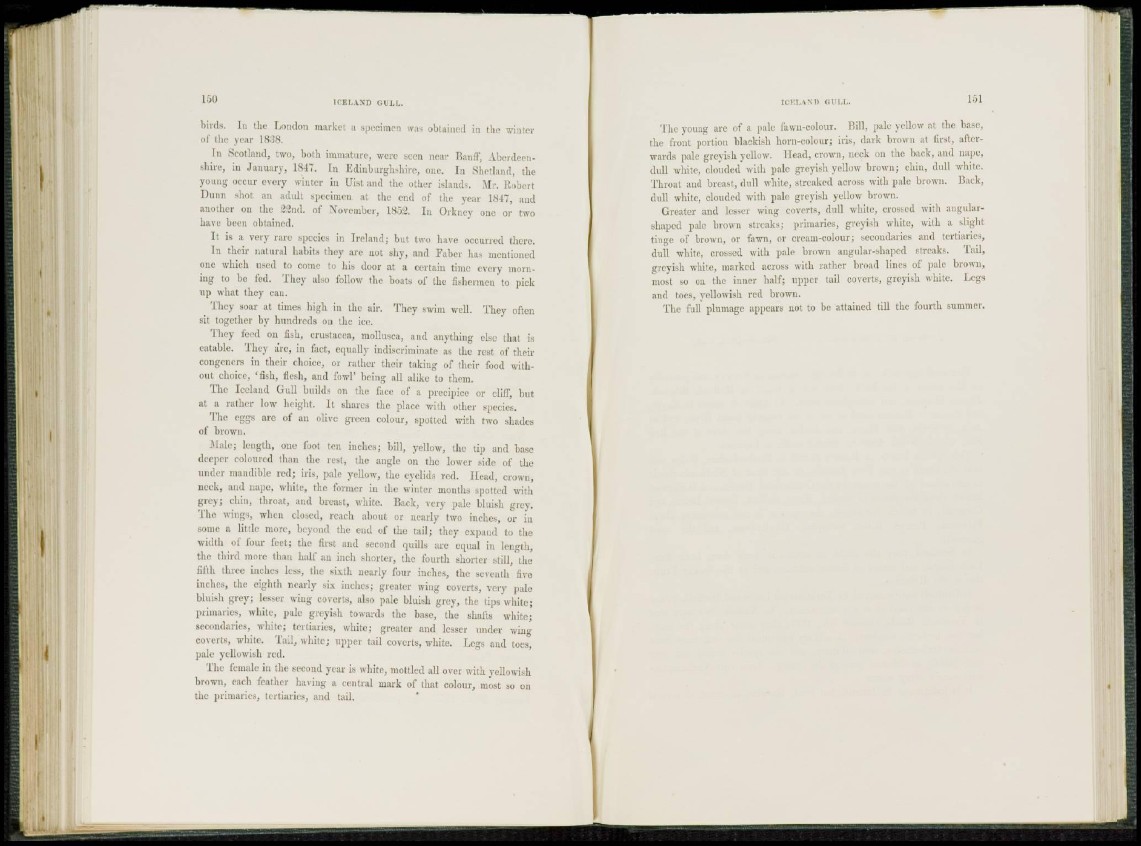
L50 ICELAND GULL,
birds. In the London market a specimen wta obtained in the winter
of the year 1838.
In Scotland, two, both immature, were seen near Banff, Aberdeenshire,
in January, 1847. In Edinburghshire, one. In Shetland, the
young occur every winter in Uist and the other islands. Mr. Robert
Dunn shot an adidt specimen at the cud of the year 1847, and
another on the &2nd. of November, 1852. In Orkney one or two
have been obtained.
I t is a very rare species in Ireland; but two have occurred there.
In their natural habits they are not shy, and Fabcr has mentioned
one which used to come to his door at a certain time every morning
to be fed. They also follow the boats of the fishermen to pick
up what they can.
They soar at times high in the air. They swim well. They often
sit together by hundreds on the ice.
They feed on fish, Crustacea, mollusca, and anything else that is
eatable. They are, in fact, equally indiscriminate as the rest of their
congeners in their choice, or rather their taking of their food without
choice, 'fish, flesh, and fowl' being all alike to them.
The Iceland Gull builds on the face of a precipice or cliff, but
at a rather low height. It shares (he place with other species.
The eggs arc of an olive green colour, spotted with two shades
of brown.
Male; length, one foot ten inches; bill, yellow, the tip and base
deeper coloured than the rest, the angle on the lower side of the
under mandible red; iris, pale yellow, the eyelids red. Head, crown,
neck, and nape, white, the former in the winter months spotted with
grey; chin, throat, and breast, white. Back, very pale bluish grey.
The wings, when closed, reach about or nearly two inches, or in
some a little more, beyond the end of the tail; they expand to the
width of four feet; the first and second quills are equal in length,
the third more than half an inch shorter, the fourth shorter still, the
fifth three inches less, the sixth nearly four inches, the seventh five
inches, the eighth nearly six inches; greater wing coverts, very pale
bluish grey; lesser wing coverts, also pale bluish grey, the tips white;
primaries, white, pale greyish towards the base, the shafts white;
secondaries, white; tertiaries, white; greater and lesser under wing
coverts, white. Tail, white; upper tail coverts, white. Legs and toes,
pale yellowish red.
The female in the second year is white, mottled all over with yellowish
brown, each feather having a central mark of that colour, most so on
the primaries, tertiaries, and tail.
ICEL VND GULL. 151
The young are of a pale lawn-colour. Bill, pale yellow at the base,
tin; front portion blackish horn-colour; iris, dark brown at first, afterwards
pale greyish yellow. Head, crown, neck on the back, and nape,
dull white, clouded with pale greyish yellow brown; chin, dull white.
Throat and breast, dull white, streaked across with pale brown. Back,
dull white, clouded with pale greyish yellow brown.
Greater and lesser wing coverts, dull while, crossed with angularshaped
pale brown streaks; primaries, greyish white, with a slight
tinge of brown, or fawn, or cream-colour; secondaries and tertiaries,
dull white, crossed with pale brown angular-shaped streaks. Tail,
greyish white, marked across with rather broad lines of pale brown,
most so on the inner half; upper tail coverts, greyish white. Legs
and toes, yellowish red brown.
The full plumage appears not to be attained till the fourth summer.